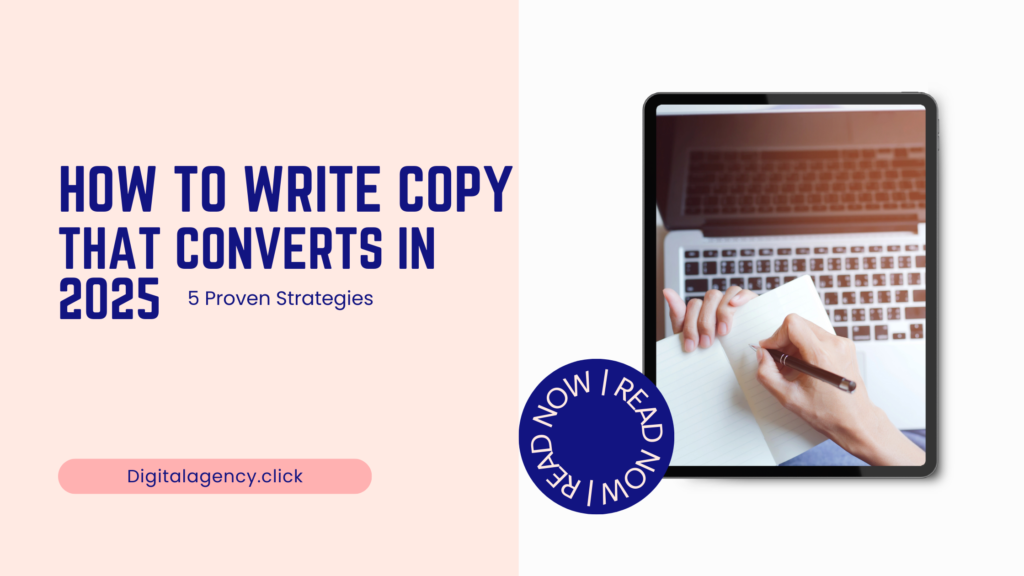In today’s fast-paced digital world, writing copy that grabs attention and drives conversions is more important than ever. With the rise of AI, changing consumer behavior, and evolving SEO practices, copywriters must stay ahead of the curve to create content that resonates with their audience. In this article, we’ll explore five proven strategies to write copy that converts in 2025.
1. Understand Your Audience Deeply
The foundation of high-converting copy lies in understanding your audience. In 2025, consumers expect personalized experiences tailored to their specific needs and desires. To achieve this, you need to invest time in thorough audience research.
Why Audience Research is Key to Conversion
Knowing your audience’s pain points, motivations, and desires allows you to craft messages that speak directly to them. When your copy addresses their specific needs, it’s more likely to resonate and drive action.
Using Data to Personalize Your Copy
Leverage tools like Google Analytics, social media insights, and customer surveys to gather data about your audience. Use this information to segment your audience and create personalized messages for each group. Personalized copy increases engagement and builds trust, which ultimately leads to higher conversion rates.
2. Focus on Emotional Appeal
Emotions play a significant role in decision-making. In fact, studies show that people are more likely to make purchasing decisions based on emotions rather than logic. In 2025, emotional copywriting will continue to be a key driver of conversions.
The Power of Emotional Copywriting
Emotional triggers such as fear of missing out (FOMO), excitement, empathy, and trust can significantly impact how your audience responds to your message. By tapping into these emotions, you can create a sense of urgency or connection that motivates readers to take action.
Examples of Emotional Triggers That Work in 2025
- Fear of Missing Out (FOMO): “Limited-time offer! Don’t miss out on this exclusive deal.”
- Empathy: “We understand how challenging it can be to find the perfect solution for your business.”
- Excitement: “Get ready for the most exciting product launch of the year!”
By incorporating emotional triggers into your copy, you can create a deeper connection with your audience and encourage them to convert.
3. Leverage Storytelling to Build Connection
Storytelling has always been an effective tool for engaging audiences, but its importance has grown even more in 2025. Consumers are bombarded with marketing messages daily, and storytelling helps cut through the noise by creating a memorable experience.
Why Storytelling is More Important Than Ever
Storytelling humanizes your brand and makes it relatable. When you tell a story that aligns with your audience’s values or experiences, you build trust and foster a deeper connection.
How to Use Storytelling in Different Types of Copy
- Product Descriptions: Instead of listing features, tell a story about how your product solves a problem or improves someone’s life.
- Landing Pages: Share customer success stories or testimonials that highlight real-world results.
- Email Campaigns: Use storytelling in email sequences to guide readers through a journey that leads them toward conversion.
By weaving storytelling into your copywriting strategy, you can engage readers on an emotional level and increase the likelihood of conversion.
4. Optimize for SEO Without Sacrificing Readability
In 2025, SEO remains crucial for driving organic traffic, but it’s important not to sacrifice readability for the sake of keyword optimization. Balancing SEO best practices with user experience is key to writing copy that converts.
Balancing SEO and User Experience
While keywords are important for ranking in search engines, overstuffing them into your content can make it difficult for readers to engage with your message. Focus on writing naturally while incorporating keywords where they fit seamlessly into the text.
Using Long-Tail Keywords for Better Conversion Rates
Long-tail keywords are specific phrases that target niche audiences who are more likely to convert. For example, instead of targeting “copywriting,” try targeting “copywriting strategies for small businesses” or “SEO copywriting tips for eCommerce.” These long-tail keywords attract users who are further along in the buying process and ready to take action.By optimizing your copy with relevant keywords while maintaining readability, you’ll improve both your search engine rankings and conversion rates.
5. Test and Refine Your Copy Regularly
Even the best-written copy may not perform as expected without testing and refinement. In 2025, A/B testing remains one of the most effective ways to optimize your copy for conversions.
The Role of A/B Testing in Copywriting Success
A/B testing involves creating two versions of a piece of copy (such as a headline or call-to-action) and testing them against each other to see which performs better. This allows you to identify what resonates most with your audience and make data-driven decisions about how to improve your copy.
Key Metrics to Track for Conversion Optimization
When testing your copy, focus on key metrics such as:
- Click-through rates (CTR): How many people click on a link after reading your copy.
- Conversion rates: How many people complete the desired action (e.g., signing up for a newsletter or making a purchase).
- Bounce rates: How quickly visitors leave your page after arriving.
By continually testing and refining your copy based on these metrics, you can ensure it remains optimized for maximum conversions.
Conclusion
Writing high-converting copy in 2025 requires a deep understanding of your audience, an emotional connection through storytelling, strategic SEO optimization, and regular testing. By implementing these five proven strategies—understanding your audience deeply, focusing on emotional appeal, leveraging storytelling, optimizing for SEO without sacrificing readability, and testing regularly—you’ll be well-equipped to create compelling content that drives results.Now it’s time to put these strategies into practice! Start crafting personalized, emotionally-driven stories that resonate with your audience—and watch as your conversion rates soar! This article is structured with SEO best practices in mind—using relevant keywords naturally throughout the text while providing valuable insights that engage readers from start to finish.
